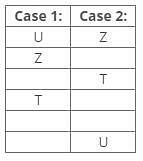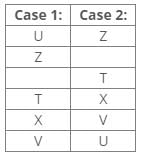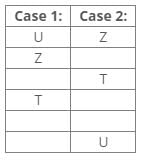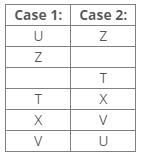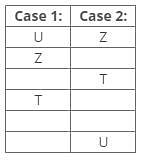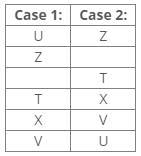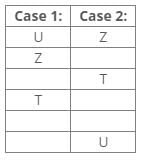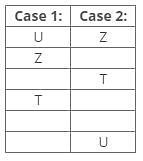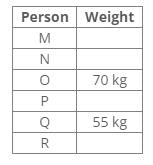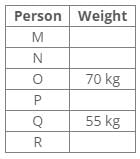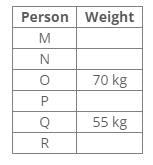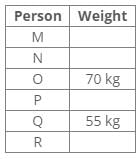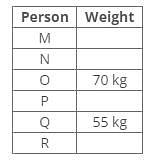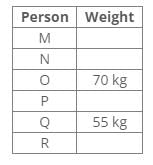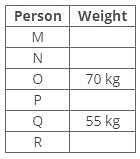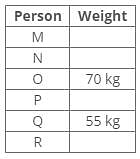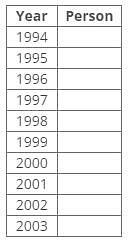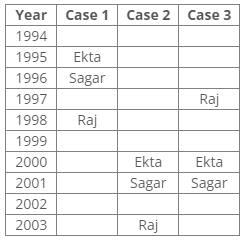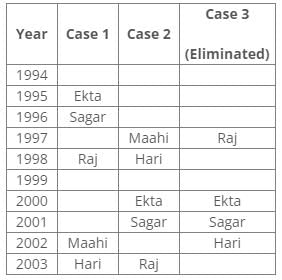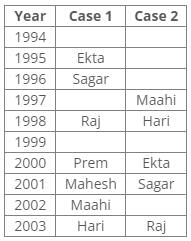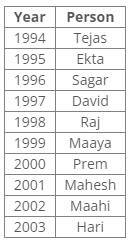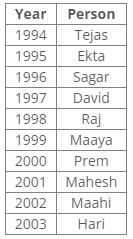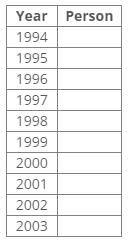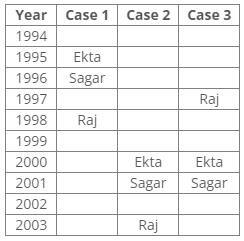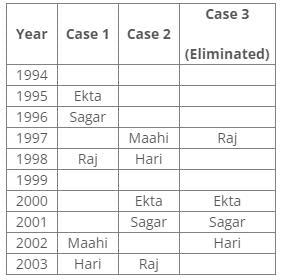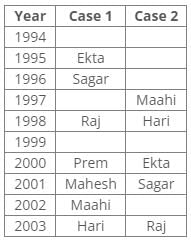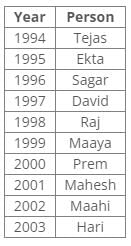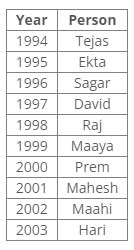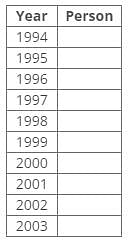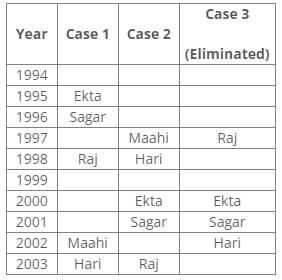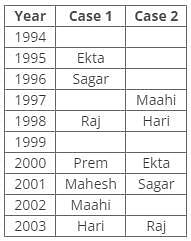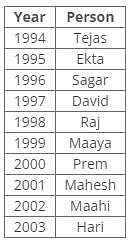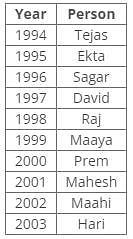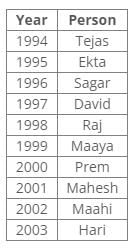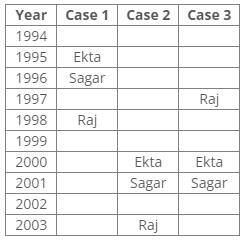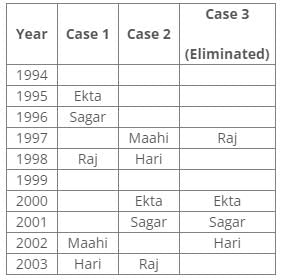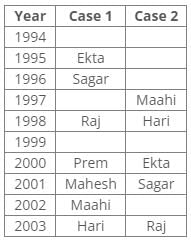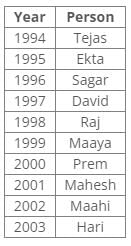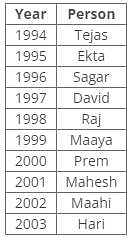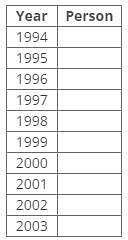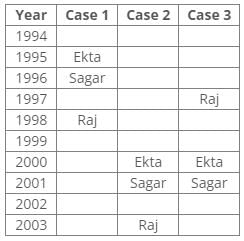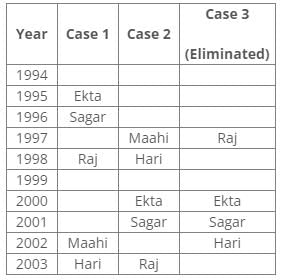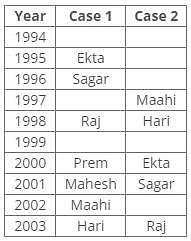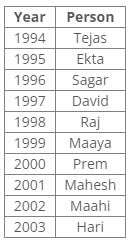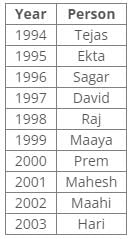MCQ: Puzzles- 1 - SSC CGL MCQ
15 Questions MCQ Test General Intelligence and Reasoning for SSC CGL - MCQ: Puzzles- 1
Direction: Study the following information and answer the given questions carefully.
Seven boxes T, U, V, W, X, Y and Z are kept one above the other in a stack. One box is placed between boxes T and Z, which is placed above T. Box V is placed below box Z. Box X is placed just above box V. Three boxes are placed between boxes X and W. Two boxes are placed between boxes T and U. Three boxes are placed between boxes V and Z.
Q. Which of the following box is placed 5th position from the bottom?
Seven boxes T, U, V, W, X, Y and Z are kept one above the other in a stack. One box is placed between boxes T and Z, which is placed above T. Box V is placed below box Z. Box X is placed just above box V. Three boxes are placed between boxes X and W. Two boxes are placed between boxes T and U. Three boxes are placed between boxes V and Z.
Direction: Study the following information and answer the given questions carefully.
Seven boxes T, U, V, W, X, Y and Z are kept one above the other in a stack. One box is placed between boxes T and Z, which is placed above T. Box V is placed below box Z. Box X is placed just above box V. Three boxes are placed between boxes X and W. Two boxes are placed between boxes T and U. Three boxes are placed between boxes V and Z.
Q. How many boxes are placed below box T?
Seven boxes T, U, V, W, X, Y and Z are kept one above the other in a stack. One box is placed between boxes T and Z, which is placed above T. Box V is placed below box Z. Box X is placed just above box V. Three boxes are placed between boxes X and W. Two boxes are placed between boxes T and U. Three boxes are placed between boxes V and Z.
| 1 Crore+ students have signed up on EduRev. Have you? Download the App |
Direction: Study the following information and answer the given questions carefully.
Seven boxes T, U, V, W, X, Y and Z are kept one above the other in a stack. One box is placed between boxes T and Z, which is placed above T. Box V is placed below box Z. Box X is placed just above box V. Three boxes are placed between boxes X and W. Two boxes are placed between boxes T and U. Three boxes are placed between boxes V and Z.
Q. How many boxes are placed between box Y and box U?
Seven boxes T, U, V, W, X, Y and Z are kept one above the other in a stack. One box is placed between boxes T and Z, which is placed above T. Box V is placed below box Z. Box X is placed just above box V. Three boxes are placed between boxes X and W. Two boxes are placed between boxes T and U. Three boxes are placed between boxes V and Z.
Direction: Study the following information and answer the given questions carefully.
Seven boxes T, U, V, W, X, Y and Z are kept one above the other in a stack. One box is placed between boxes T and Z, which is placed above T. Box V is placed below box Z. Box X is placed just above box V. Three boxes are placed between boxes X and W. Two boxes are placed between boxes T and U. Three boxes are placed between boxes V and Z.
Q. If we arrange all the boxes according to the English alphabetical order from top to bottom then how many boxes remain in the same position?
Direction: Study the following information and answer the given questions carefully.
Seven boxes T, U, V, W, X, Y and Z are kept one above the other in a stack. One box is placed between boxes T and Z, which is placed above T. Box V is placed below box Z. Box X is placed just above box V. Three boxes are placed between boxes X and W. Two boxes are placed between boxes T and U. Three boxes are placed between boxes V and Z.
Q. Find the odd one out?
Direction: Study the following information and answer the given questions carefully.
Six people R, Q, P, O, N and M have different weights in kg. The weight of O is 70kg and only two people are heavier than O. P, who is not the lightest, is lighter than O. R is lighter than Q and N is lighter than M. P is heavier than Q, whose weight is 55kg.
Q. How many people are lighter than N?
Direction: Study the following information and answer the given questions carefully.
Six people R, Q, P, O, N and M have different weights in kg. The weight of O is 70kg and only two people are heavier than O. P, who is not the lightest, is lighter than O. R is lighter than Q and N is lighter than M. P is heavier than Q, whose weight is 55kg.
Q. Which of the following can be the weight of P?
Direction: Study the following information and answer the given questions carefully.
Six people R, Q, P, O, N and M have different weights in kg. The weight of O is 70kg and only two people are heavier than O. P, who is not the lightest, is lighter than O. R is lighter than Q and N is lighter than M. P is heavier than Q, whose weight is 55kg.
Q. What is the possible tank capacity of Car N?
Direction: Study the following information and answer the given questions carefully.
Six people R, Q, P, O, N and M have different weights in kg. The weight of O is 70kg and only two people are heavier than O. P, who is not the lightest, is lighter than O. R is lighter than Q and N is lighter than M. P is heavier than Q, whose weight is 55kg.
Q. How many cars have lower tank capacity than Car R?
Direction: Study the following information and answer the given questions carefully.
Six people R, Q, P, O, N and M have different weights in kg. The weight of O is 70kg and only two people are heavier than O. P, who is not the lightest, is lighter than O. R is lighter than Q and N is lighter than M. P is heavier than Q, whose weight is 55kg.
Q. If the average tank capacity of Cars T and G is 55 liters, then what could be the possible tank capacity of Car K?
Direction: Study the following information and answer the given questions carefully.
Ten people were born in ten different years from 1994 to 2003. Two people were born between Ekta and Raj. Maahi was born immediately before Hari. Four people were born between Hari and Raj. Sagar was born immediately after Ekta. Mahesh was born after Prem. David was born after Tejas but before Maya. Ekta was born in a year which is a multiple of 5. Three people were born between Prem and Sagar.
Q. Who among the following was born in 2002?
Direction: Study the following information and answer the given questions carefully.
Ten people were born in ten different years from 1994 to 2003. Two people were born between Ekta and Raj. Maahi was born immediately before Hari. Four people were born between Hari and Raj. Sagar was born immediately after Ekta. Mahesh was born after Prem. David was born after Tejas but before Maya. Ekta was born in a year which is a multiple of 5. Three people were born between Prem and Sagar.
Q. How many persons were born between Prem and Maaya?
Direction: Study the following information and answer the given questions carefully.
Ten people were born in ten different years from 1994 to 2003. Two people were born between Ekta and Raj. Maahi was born immediately before Hari. Four people were born between Hari and Raj. Sagar was born immediately after Ekta. Mahesh was born after Prem. David was born after Tejas but before Maya. Ekta was born in a year which is a multiple of 5. Three people were born between Prem and Sagar.
Q. Find the odd one out.
Direction: Study the following information and answer the given questions carefully.
Ten people were born in ten different years from 1994 to 2003. Two people were born between Ekta and Raj. Maahi was born immediately before Hari. Four people were born between Hari and Raj. Sagar was born immediately after Ekta. Mahesh was born after Prem. David was born after Tejas but before Maya. Ekta was born in a year which is a multiple of 5. Three people were born between Prem and Sagar.
Q. Who is the youngest person?
Direction: Study the following information and answer the given questions carefully.
Ten people were born in ten different years from 1994 to 2003. Two people were born between Ekta and Raj. Maahi was born immediately before Hari. Four people were born between Hari and Raj. Sagar was born immediately after Ekta. Mahesh was born after Prem. David was born after Tejas but before Maya. Ekta was born in a year which is a multiple of 5. Three people were born between Prem and Sagar.
Q. In which year was Mahesh born?
|
177 videos|126 docs|197 tests
|
|
177 videos|126 docs|197 tests
|



